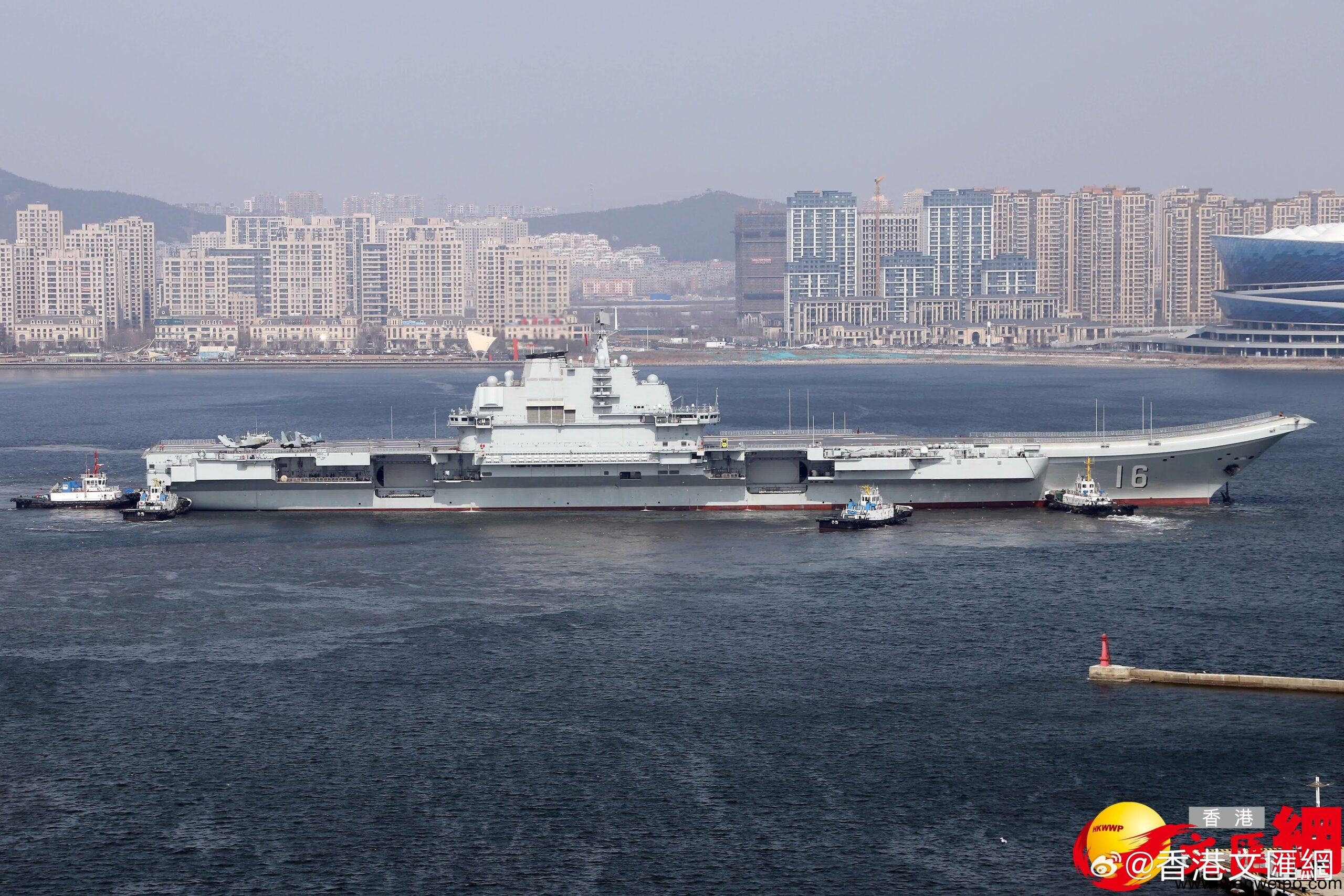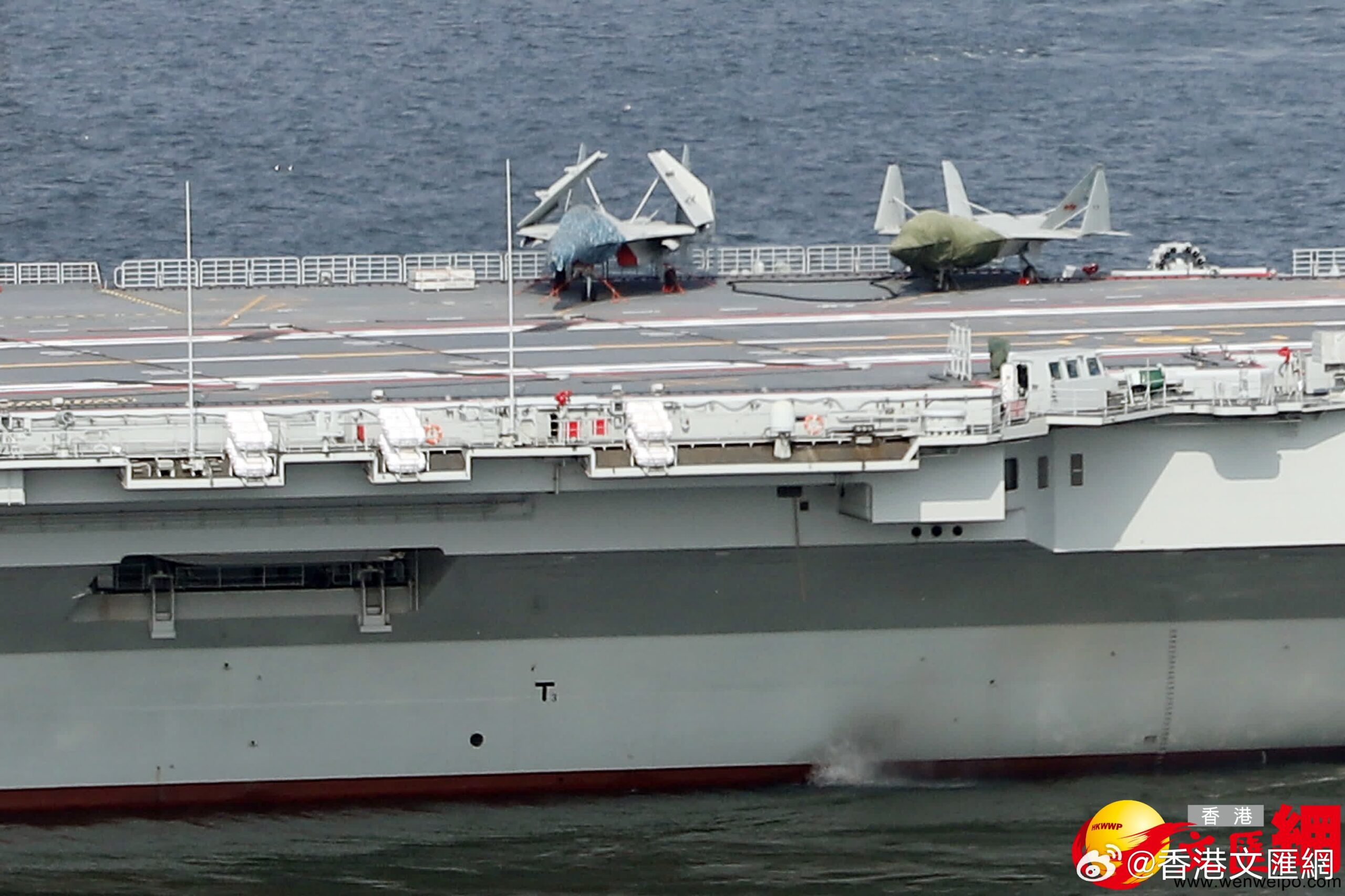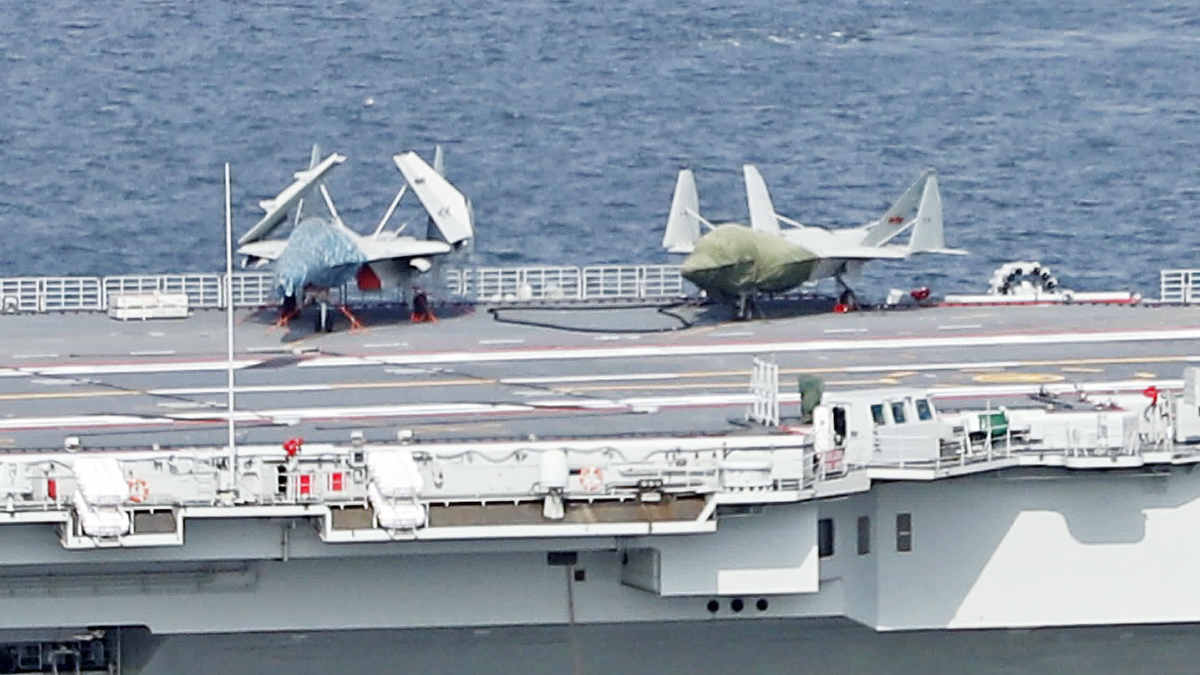New photos and video have emerged, providing us with a much better view of the mockup of China’s stealthy J-35 carrier-capable fighter aboard the aircraft carrier Liaoning. While we had previously seen the test specimen on the carrier while it was in port, it’s now clear that deck-handling trials are continuing with the overhauled warship now going to sea. The development raises more questions about what the future makeup of the Chinese carrier air wing will look like.



As you can read about in our previous analysis, sightings of the J-35 mockup on the Liaoning earlier this month suggested that the stealth fighter may be headed for an embarked career aboard China’s first two carriers, which are not fitted with catapults. In the past, it had been expected that the carrier-capable J-35 was intended for China’s next-generation carriers, which will use catapults rather than ‘ski jump’ ramps to get aircraft airborne.

A full-size mockup of the J-35 had been sighted previously, too, including aboard China’s land-based carrier test facility in Wuhan, where such aircraft ‘shapes’ are evaluated for potential use at sea. With the mockup now uncovered, the latest imagery indicates that it wears a light-gray paint scheme the same as that worn by in-service J-15 carrier fighters.
The following series of photos shows the full-size mockup of the J-35 aboard Liaoning earlier this year before it had left port after its latest overhaul:



At the same time, the latest photos and video also show a mockup of a J-15 on the Liaoning. The basic J-15 is now a well-established part of the air wings of China’s two in-service carriers — Liaoning and Shandong — but a mockup might still be useful for continued training, as well as how the aircraft might interact with the J-35 around the deck and in the hangar.
But there have been suggestions that the mockup in question could represent a newer version of the J-15. Although covered by a tarpaulin, the cockpit shape suggests that it could be a two-seat derivative.
According to Andreas Rupprecht, a longtime China aerospace observer and contributor to The War Zone, there are rumors that the J-15 mockup (or mockups, with potentially two now onboard) are for tests of the electronic warfare version of the aircraft. Likely known as the J-15D, this two-seater is essentially a Chinese equivalent to the U.S. Navy’s EA-18G Growler and an important part of the ongoing modernization of the People’s Liberation Army Navy (PLAN) carrier air wing. It remains little seen, however, and fairly mysterious.
A pair of mockup J-15Ds also previously appeared on the Shandong, back in 2022, as seen in the tweet below. Noteworthy is the fact that these mockups were single-seaters; the J-15D is a two-seater, but this level of accuracy was obviously not deemed relevant for deck-handling trials. The J-15 mockup on the Liaoning lacks wingtip pods (or pylons, for that matter) but they could be added later.
A Chinese carrier going to sea with aircraft mockups onboard is “not that usual, but also not unusual,” Rupprecht told us. Their role is to practice deck-handling movements, including using the elevators that move aircraft between the flight deck and the hangar below.
Deck-handling aids of different kinds are a familiar part of aircraft carrier training in general and can take a variety of forms. The U.S. Navy will crane real aircraft onto carriers for deck-handling trials, while the Indian Navy trains its deck crew using very basic replica ‘shapes’ that represent the dimensions of the actual aircraft, but little else.
Now that Liaoning has completed its overhaul, it seems that carrier-compatibility tests with the J-35 and potential J-15D (or another kind of naval Flanker variant) are now going to be undertaken in the more realistic and demanding environment of at-sea operations.

Taken together, the two mockups provide further evidence that China may be looking at the possibility of significantly upgrading the airpower capabilities of both the Liaoning and Shandong.
Currently, these vessels go to sea with air wings made up of up to a maximum of 24 J-15 fighters. These are typically supported by around two Z-18F anti-submarine warfare helicopters, two Z-18JA airborne early warning helicopters, and a pair of smaller Z-9 helicopters for plane-guard and general utility duties.

Unlike the Russian Su-33 from which it was derived, the Chinese-made J-15 has a fairly robust precision-attack capability with YJ-83K anti-ship missiles and YJ-91 anti-radiation missiles, as well as carrying locally developed air-to-air missiles of various types. Other improvements over the Su-33 include locally developed avionics and now also Chinese-made engines.
As we have explored before, having the J-35 join the air wing of either of these carriers would be a huge boost. As well as its low-observable characteristics, it’s assumed that the production aircraft will feature an active electronically scanned array (AESA) radar among a host of advanced sensors, as well as very capable weaponry.

Since the Liaoning and the Shandong are equipped for short takeoff but arrested recovery, or STOBAR, operations, the J-35 would have to make use of the ski-jump ramp on the bow to launch, and then recover using arrester wires.
This arrangement limits the payload of the J-15 when operating from these warships, but as we’ve pointed out in the past, the J-35, which is intended to carry more limited stores internally, may be less dramatically affected than other types.
Having the J-35 conduct regular operations from the Liaoning and the Shandong may not have been expected by most observers, but it would make some sense, if feasible, not least to gather valuable experience with the aircraft before expanding its concept of operations aboard the PLAN’s next aircraft carrier, the Fujian. This warship deletes the bow ramp and instead will make use of catapult-assisted takeoff but arrested recovery, or CATOBAR, operations. Using catapults, specifically the advanced electromagnetic aircraft launch system (EMALS) type, will allow the J-35 (or other fixed-wing aircraft) to operate from the carrier with much heavier fuel and weapons loads.
A useful comparison of the Chinese aircraft carriers Liaoning (CV-16), Shandong (CV-17), and Fujian (CV-18):
“In my opinion [the J-35 joining the Liaoning and the Shandong] makes perfect sense,” Rupprecht continues. “Before the Fujian is ready, especially as an operational carrier, the PLAN will need to spend a lot of time training with the J-35 on the deck and in the air. Even if the training is limited due to not having a catapult, the PLAN can gain a lot of flight hours and a lot of experience.”
Provided the J-15 mockup is intended to replicate the J-15D, the same applies in this case, as well. Currently, the air wings of the Liaoning and the Shandong don’t include dedicated electronic warfare aircraft. The J-15D would open up a whole new range of missions for China’s existing carriers, were it to be embarked.
There have also been suggestions that the J-15D could be a lot more than simply an escort jammer type, too. Some accounts suggest the J-15D is heavily inspired by the land-based J-16D ‘Wild Weasel’ variant, reflected in the similar wingtip electronic warfare pods and revised radome profile. Like the J-16D, the infrared search and track sensor and internal gun are removed. As on the J-16D, further electronic warfare pods are expected to be carried under the J-15D’s wings, while it is also rumored to be intended for offensive operations, using anti-radiation missiles and perhaps other weapons.

While the first two prototype J-15Ds were equipped for STOBAR rather than CATOBAR operations, the assumption was again that, in the end, this variant would be optimized for use on the Fujian and subsequent carriers. Now, the latest evidence suggests that might have to be revised. It could be the case that China has ambitions to put J-35s and J-15Ds aboard its first-generation ‘ski-jump carriers’ as well.
If that turns out to be the case, it would be a good preparation for the Fujian and the PLAN’s future CATOBAR operations. China has also developed a CATOBAR version of the J-15 and these same modifications could also be incorporated in the J-15D. Then, once the J-35 and J-15 go to sea aboard the Fujian, they will be able to take advantage of the performance and capability advantage offered by catapult launch, as well as working alongside the KJ-600 carrier radar plane as a valuable force-multiplier. Carrier-based drones also seem likely to be part of the PLAN’s future air wings, too.

As with much in China’s military aerospace realm, there are many uncertainties regarding plans for its future carrier force and the aircraft that will equip it. It’s clear, however, that this remains a highly dynamic and fascinating area of development.
Contact the author: thomas@thewarzone.com
